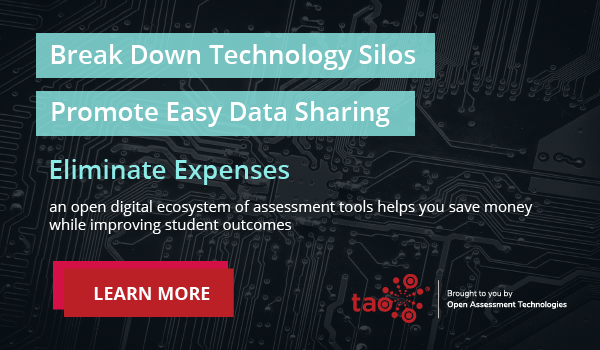Artificial intelligence, or AI, is one of the latest trends in education and in how we design and implement assessments. In education, AI has the potential to change how we assess students and may be used to enhance or improve student assessment outcomes. When many educators think about AI in assessment they may think about students using AI to cheat on exams or to write essays. However, AI assessment software has benefits in the classroom that extend far beyond the negative impacts of cheating.
Generally speaking, AI in assessment empowers educators to process more information and data, develop new materials quickly, and can be used in assessment to provide students with individualized assessment items that can adapt to student needs. Through assessment utilizing AI educators can increase student growth and better gauge student learning.
Transforming Education through Artificial Intelligence
AI has the potential to revolutionize student learning outcomes and performance by personalizing education, providing immediate feedback, and enhancing the overall learning experience. Through adaptive learning algorithms, AI can assess each student’s strengths and weaknesses, creating tailored learning paths that cater to individual needs and learning styles. This personalization ensures that students receive the right level of challenge and support, fostering deeper understanding and engagement with the material.
Personalized Learning Experiences & Adaptive Testing
Personalized learning experiences and adaptive testing with AI have the potential to significantly improve student learning outcomes by tailoring educational content and assessments to individual student needs. Some ways that AI enables personalize learning experiences include:
- Custom content creation: AI-driven personalized learning platforms can analyze individual student’s strengths, weaknesses, and learning styles and develop content based on a student’s needs.
- Individualized pacing: AI in assessment enables personalized learning, allowing students to progress through materials at their own pace. Advanced students can move faster through content, while those who need more time can review and practice until they master a concept.
- Targetted remediation: When a student struggles with a particular topic, AI can identify the areas of difficulty and provide additional resources, exercises, or explanations specifically tailored to address those challenges.
- Continuous assessment: AI can provide ongoing, real-time feedback on student performance. This allows students to monitor their progress, identify areas where improvement is needed, and make adjustments accordingly.
Accessibility Tools
Artificial Intelligence (AI) has the potential to transform accessibility tools for students by making educational materials and resources more inclusive and accessible to individuals with various learning needs and disabilities.
- Text-to-Speech (TTS): AI-powered TTS technology can convert written text into spoken language. This helps students with visual impairments, dyslexia, or reading difficulties access written content in an auditory format.
- Speech-to-Text (STT): STT technology can transcribe spoken language into written text, benefiting students who have difficulty with handwriting, typing, or verbal communication.
- Language Translation and Localization: AI-driven language translation tools can make educational materials available in multiple languages, allowing students who are non-native speakers or have limited proficiency in a particular language to access content in their preferred language.
- Customizable Fonts and Formatting: AI can enable the customization of fonts, font sizes, text spacing, and formatting to meet the specific visual needs of individual students. This helps students with visual impairments or reading-related challenges.
- Content Summarization and Simplification: AI-powered tools can summarize and simplify complex text, making it more accessible to students with cognitive disabilities, such as ADHD or specific learning disabilities.
- Real-time Captioning and Sign Language Interpretation: AI can provide real-time captioning for video content, ensuring that students with hearing impairments can access audio content. It can also offer sign language interpretation for live lectures and presentations.
- Personalized Learning Pathways: AI can analyze individual learning styles and preferences to create personalized learning pathways and recommend suitable learning resources, making education more accessible and engaging for all students.
- Assistive Devices Integration: AI can integrate with assistive devices like screen readers, Braille displays, or eye-tracking devices to enhance accessibility further.
- Accessible Content Creation: AI tools can assist educators in creating accessible content from the start, ensuring that materials are designed with accessibility in mind. This includes generating alternative text for images, ensuring proper document structure, and enhancing readability.
Faster Performance Analysis
Using AI, student work can be assessed and scored in real-time and with in-context feedback. This means that students do not have to wait for a teacher to score their work over a couple of days, instead, they can get feedback immediately and correct their course if needed. Faster performance analysis may boost engagement and reduce teacher workload.
Additionally, getting student scores out quicker using AI assessment software allows teachers to look at data and analytics in real-time. This additional speed gives teachers the freedom to make changes in real-time and adjust instruction as needed.
Reduce Human Error with Automated Scoring
When an educator is processing large amounts of student data there is the potential for errors that may impact grades or give the educator incorrect data related to a student’s ability. Through AI automated scoring, errors can be reduced and data can be leveraged in new impactful ways. Using AI, educators may also assess students on long-form answers such as essays in a more equitable manner.
All of this also serves to help educators work more efficiently as well. Rather than going through and grading by hand, AI-enabled assessment scoring can provide feedback to an entire class quickly and accurately.
Student Remediation Plans
Developing student remediation plans using AI involves leveraging artificial intelligence to identify areas where students are struggling and creating tailored strategies to help them improve. AI in assessment can be used to provide students with resources designed to enhance learning based on student ability. It also may provide real-time feedback and communication between all stakeholders, including teachers, students, and parents.
Through data collection and AI analysis, at-risk students may be more accurately and efficiently identified, and supporting materials can be delivered to move the students forward in their learning at their level. Developing student remediation plans using AI is an ongoing process that requires collaboration among educators, administrators, and AI specialists. The goal is to provide targeted support to struggling students, enhance their learning experiences, and help them achieve academic success.
Making AI an Asset Education
Integrating artificial intelligence (AI) as an asset in the classroom can enhance the teaching and learning experience. Here are steps to effectively incorporate AI into educational settings:
- Define Clear Educational Goals: Begin by identifying specific educational goals and learning outcomes that you want to achieve with the help of AI. Consider what you want students to learn and how AI can support those objectives.
- Assess Available AI Tools and Resources: Explore the wide range of AI tools and resources available for education. This includes AI-powered software, learning platforms, chatbots, virtual tutors, and more. Assess which ones align with your educational goals.
- Provide Training and Professional Development: Ensure that educators, staff, and students are trained to use AI tools effectively. Offer professional development opportunities to help teachers integrate AI into their teaching methods.
- Select Appropriate AI Solutions: Choose AI solutions that are well-suited to your educational context and objectives. Consider factors such as the age group of students, subject matter, and technology infrastructure.
- Customize Learning Experiences: Use AI to personalize learning experiences for students. AI can analyze student data to create tailored learning paths, suggest resources, and adapt content to individual learning styles and abilities.
- Promote Engagement and Interactivity: Incorporate AI-driven interactive elements into lessons, such as virtual labs, simulations, and gamified content. AI can provide real-time feedback and support to keep students engaged.
- Enhance Administrative Tasks: Utilize AI for administrative tasks like grading, scheduling, and student management. This frees up educators to focus more on teaching and mentoring.
- Data Analysis and Insights: Leverage AI assessment software to collect and analyze data on student performance. Insights from AI can help identify areas where students may need additional support or where instructional strategies can be improved.
- Feedback Mechanisms: Implement AI-driven feedback mechanisms that provide instant feedback to students on their work. This can help them understand their progress and make necessary adjustments.
- Accessibility and Inclusivity: Ensure that AI tools and resources are accessible to all students, including those with disabilities. Make accommodations as necessary to create an inclusive learning environment.
- Stay Informed: Keep up to date with advancements in AI assessment software and their applications in education. As technology evolves, new opportunities for enhancing the classroom experience may emerge.
- Support and Resources: Provide ongoing technical support and resources for educators and students using AI tools. Address any technical issues promptly to minimize disruptions.
Questions to consider
When implementing AI assessment software in the classroom, it’s important to consider various factors to ensure its successful integration and effectiveness. Here are some key questions to consider:
- What specific educational goals and learning outcomes do you aim to achieve with AI integration?
- How will AI support and enhance the achievement of these goals?
- How do the needs and learning styles of your students vary, and how can AI be used to address these individual differences?
- Is the AI solution accessible and inclusive for all students, including those with disabilities?
- Have educators received adequate training to use AI tools in the classroom effectively?
- Is there ongoing professional development and technical support available for teachers?
- What measures are in place to protect student data and ensure data privacy and security?
- How are you complying with relevant data protection regulations?
- How will AI be used to provide feedback to students on their progress and performance?
- How can AI support assessment and grading processes?
- What resources, including technology infrastructure and budgets, are required to implement AI effectively?
- How will you monitor the impact of AI assessment software on teaching and learning?
—
Integrating a robust artificial intelligence system into your assessments gives teachers more flexibility to design personalized assessments while leveraging large data sets to improve student learning. AI also provides students with engaging test material that may adapt to their level and provide real-time feedback and remediation.
An AI-driven assessment is only as good as its online assessment management system. Through the TAO platform educators can develop and design assessments with artificial intelligence embedded directly into test items, giving students what they need, when they need it. All of this serves to enhance student engagement and increase student growth and learning.


